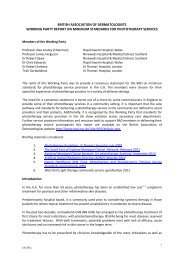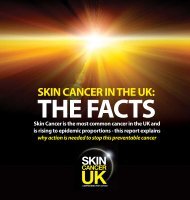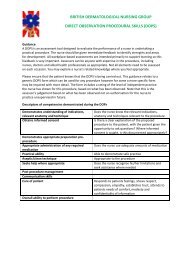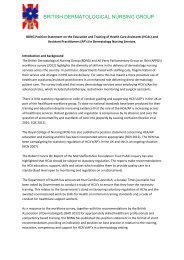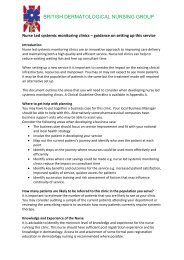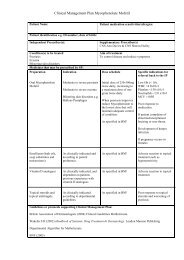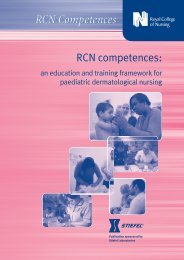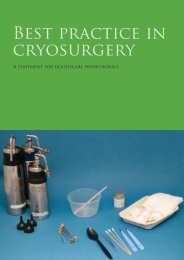Improving outcomes for people with skin tumours including melanoma
Improving outcomes for people with skin tumours including melanoma
Improving outcomes for people with skin tumours including melanoma
You also want an ePaper? Increase the reach of your titles
YUMPU automatically turns print PDFs into web optimized ePapers that Google loves.
Diclofenac 3% gel (Solaraze) is licensed <strong>for</strong> the treatment of AK.<br />
This is a widely used treatment <strong>for</strong> AK, <strong>with</strong> a favourable<br />
tolerability profile <strong>for</strong> primary care use.<br />
• Photodynamic therapy (PDT). PDT involves the use of light<br />
therapy in combination <strong>with</strong> a topical photosensitising agent to<br />
destroy cancer cells. Its use has been well described in the<br />
treatment of AK, in situ SCC and superficial BCC. The<br />
advantages of PDT include a low rate of adverse effects and<br />
good cosmesis. The disadvantages are that the patient has to be<br />
available <strong>for</strong> a period of at least 3–4 hours <strong>for</strong> treatment, and<br />
that the photosensitiser and equipment are relatively expensive.<br />
A role <strong>for</strong> systemic PDT is being explored. At present there is<br />
little in<strong>for</strong>mation available on long-term cure rates.<br />
<strong>Improving</strong> Outcomes <strong>for</strong><br />
People <strong>with</strong> Skin Tumours<br />
<strong>including</strong> Melanoma<br />
Initial investigation,<br />
diagnosis, staging and<br />
management<br />
• Mohs micrographic surgery. Mohs micrographic surgery is a<br />
precise technique in which excision of the <strong>skin</strong> lesion (usually a<br />
BCC) is carried out in stages and each stage checked<br />
histologically. It is advocated <strong>for</strong> use in cases where it is critical<br />
to obtain a clear margin while preserving the maximum amount<br />
of normal surrounding tissue, in particular <strong>for</strong> recurrent and<br />
high-risk aggressive growth pattern BCCs such as morphoeictype<br />
BCCs. The main problems <strong>with</strong> this technique include the<br />
length of the procedure, the need <strong>for</strong> special equipment and<br />
training, and the relatively high cost. The availability of the<br />
procedure in the UK is, at present, limited.<br />
4<br />
• Radiotherapy. Radiotherapy is a useful treatment <strong>for</strong> a subset<br />
of patients <strong>with</strong> NMSC who cannot or prefer not to be treated by<br />
surgery. The cure rates are over 90% <strong>for</strong> most <strong>skin</strong> lesions, but<br />
the long-term cosmesis, particularly <strong>for</strong> young patients, is inferior<br />
to that following other treatments. The same area cannot be<br />
treated twice and so, if there is a recurrence, surgery is needed,<br />
which may be more difficult than if the lesion had been<br />
removed surgically to start <strong>with</strong>. Radiotherapy can also be used<br />
in cases when the margins of excision appear to be incomplete<br />
on histopathological examination. It should not be used to treat<br />
patients <strong>with</strong> Gorlin’s syndrome because of the carcinogenic<br />
potential of low-dose irradiation at the margins of the treated<br />
areas.<br />
Traditionally radiotherapy <strong>for</strong> <strong>skin</strong> cancer has been given <strong>with</strong><br />
superficial (orthovoltage) X-ray machines. High-energy electron<br />
(linear accelerator) treatments are increasingly being used, but<br />
orthovoltage treatment may be easier to use <strong>for</strong> small <strong>tumours</strong><br />
and <strong>for</strong> frail patients. It is there<strong>for</strong>e important that radiotherapy<br />
departments continue to provide access to such machines.<br />
Guidance on cancer services: <strong>skin</strong> <strong>tumours</strong> <strong>including</strong> <strong>melanoma</strong> 83




